The Economics and Statistics Division maintains archives of previous publications for accountability purposes, but makes no updates to keep these documents current with the latest data revisions from Statistics Canada. As a result, information in older documents may not be accurate. Please exercise caution when referring to older documents. For the latest information and historical data, please contact the individual listed to the right.
<--- Return to Archive
For additional information relating to this article, please contact:
December 17, 2020NOVA SCOTIA QUARTERLY POPULATION ESTIMATES AS OF OCTOBER 1, 2020 The production of the demographic estimates are based on methods and models that allow reliable and accurate population estimates; however, in the context of the COVID-19 pandemic, the assumptions of the models maybe invalid and administrative data sources are not optimal in terms of timeliness and completeness. Statistics Canada made adjustments to some components of the third quarter demographic estimates to account for the impact of the COVID-19 pandemic. These adjustments closely follow what was done in the second quarter of 2020. Details can be found in the Q2 2020 technical supplement.
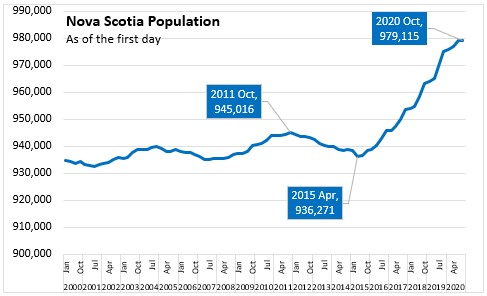
Nova Scotia’s population decreased by 236 between July 1, 2020 and October 1, 2020. The population as of October 1, 2020 was 979,115, the second highest population for Nova Scotia on record. Since April 1, 2015 Nova Scotia's population has increased by 42,844. This quarter's decline reflects fewer immigrants and non-permanent residents, as well as less natural population decline and a net gain in interprovincial migration.

There are seasonal patterns in quarterly population changes, particularly evident in births and migration. In the third quarter of 2020, Nova Scotia posted the first quarterly population decline since Q4 2016, largely on reduced immigration and non-permanent residents. Statistics Canada noted that restrictions on international travel imposed in March to curb the spread of COVID-19 has had a profound impact on immigration and population growth in 2020.
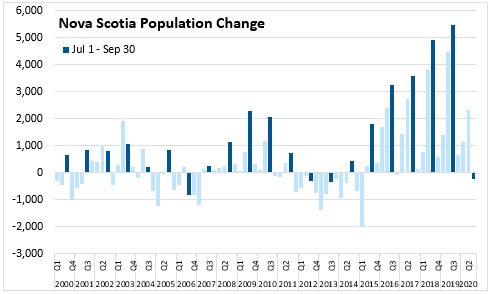
In the third quarter, Nova Scotia’s population decreased 0.02% compared to the July 1 estimate, while the national population grew 0.01%. Compared with October 1, 2019 Nova Scotia’s population increased 0.40% (+3,884), while the national population grew by 0.54%.

Immigration from other countries has been a strong contributor to population growth in Nova Scotia in recent years. In Q3 2020 immigration slowed across Canada, with total international migration turning negative for only the second time in any quarter since Q3 1971. Nova Scotia received 733 immigrants during the third quarter of 2020, down from 2,469 reported for Q3 2019.

In this quarter, Nova Scotia saw a net loss of 2,289 non-permanent residents since July 1, 2020, compared to positive net gains for Q3 in recent years (+1,983 in Q3 2019 and +2,463 in Q3 2018).
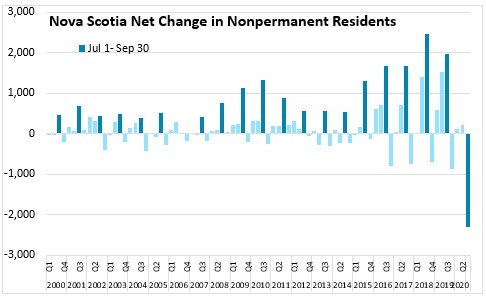
Nova Scotia’s natural population change (the number of births less the number of deaths) has been negative for several years. Between July 1, 2020 and September 30, 2020, there were 2,246 births and 2,353 deaths, amounting to a natural population decline of 107.

Despite fewer movements between provinces and territories than usual, Nova Scotia posted the highest net interprovincial migration gain (+1,471) since the third quarter of 1984. There were 4,098 in-migrants and 2,627 out-migrants (lower than Q3 in previous years). Although migration flows from other provinces generally slowed compared to Q3 2019, there were net gains to Nova Scotia from every province. The largest net gains came from Ontario, followed British Columbia and New Brunswick.
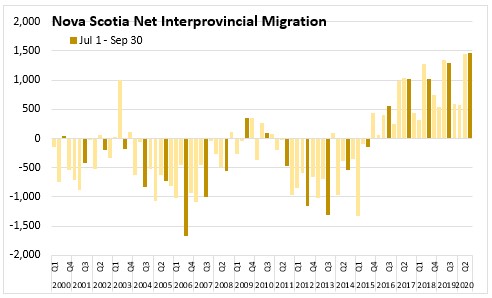
Out-migration from Nova Scotia to other provinces decreased by 1,246 compared to the third quarter of 2019. Out-migration declines were mostly from fewer movers to Ontario, Alberta, and Quebec.

Compared to Q3 2019, in-migrants to Nova Scotia decreased by 1,142. The largest in-migrant declines were from fewer people moving from Ontario, Alberta and British Columbia.
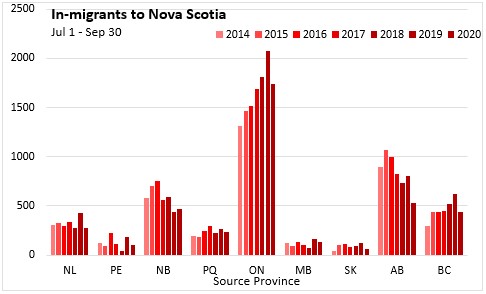
Interprovincial migration to Nova Scotia was a net inflow of 1,471 persons in Q3 2020 (including the territories). There were net inflows from all provinces with the largest coming from Ontario (+745), British Columbia (+188) and New Brunswick (+135).
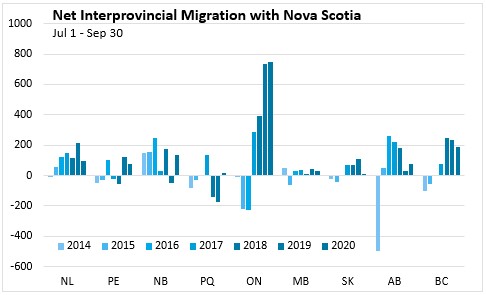
Source: Statistics Canada.
Table 17-10-0009-01 Population estimates, quarterly
Table 17-10-0020-01 Estimates of the components of interprovincial migration, quarterly
Table 17-10-0040-01 Estimates of the components of international migration, quarterly
Table 17-10-0045-01 Estimates of interprovincial migrants by province or territory of origin and destination, quarterly
Table 17-10-0059-01 Estimates of the components of natural increase, quarterly
<--- Return to Archive